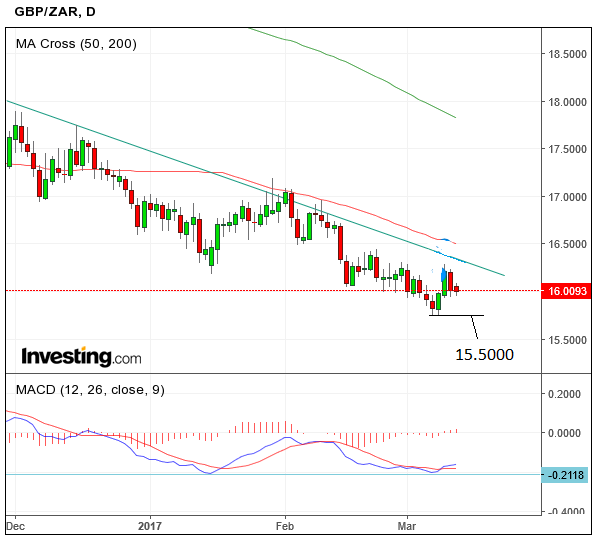Pound's Downtrend Against Rand Tipped to Extend: The Next Targets

GBP/ZAR continues to edge lower as the Pound loses ground on a combination of negative interest rate expectations and Brexit worries, whilst a resurgence of risk talking has helped the Rand.
With no major signs of the downtrend ending yet, we forecast it to continue lower, with a break below the 15.7500 confirming a continuation down to 15.5000.
The pair is below both the 50 and 200-day moving averages and the downtrend confirms with the medium-term downtrend.
Despite momentum converging marginally on the most recent low, it is not sufficiently acute to indicate a reversal of the trend.

Data Implications For the Rand in the Coming Week
The most significant influence on the Rand this week is likely to be the Fed March interest rate meeting at 18.00 GMT on Wednesday 15.
A rate hike is now inevitable and therefore already priced into exchange rates – what is more likely to move markets, including the Rand, is the Fed’s outlook for where rates are likely to go afterwards, in the rest of the year and in 2018.
One possibility is that the Fed’s dot-plot diagram which shows Fed member expectations for the future path of interest rates shows more members shifting to the consensus of a total of three rate hikes in 2017.
Such a move could weaken the Rand as it will impact negatively on the outlook for emerging market currencies.
This is because many companies in the emerging markets have US debt, and so a rise interest rates would increase their repayments.
Another possibility is the dot-plot reflects a shift in the Fed’s consensus of three rate rises in 2017 to a new total of four.
Additionally, the current dot-plot expectations of only two rate hikes in 2018, could also increase to three.
“The rand has shown remarkable resilience in the face of rising Fed hike expectations — the sell-off of late last week was mild and did not sustain even in the face of the strong US payrolls figure. Still, expect some rand weakness if an upward shift in the dot plots causes a similar rise in market expectations,” said Rand Merchant Bank’s John Cairns.
Part of the reason for the Rand’s remarkable resilience may be due to the fact it is not as exposed to the US or the fluctuations of the Dollar as many other currencies.
A recent study from Morgan Stanley noted how the Rand was actually one of the less exposed EM economies to Trump’s protectionist and reflationary economic policies.
Data for the Pound in the Week Ahead
The meeting of the Bank of England (BOE) on March 16 at 12.00 GMT is the highlight of the week ahead for Sterling.
Although no-change in policy is expected, the minutes which are released at the same time as the decision, will show how members deliberated on monetary policy issues.
Whilst some commentators had seen the BOE moving towards a tighter monetary policy stance, this has probably changed since the spring Budget statement.
There is now a heightened possibility that the BOE will have to keep monetary policy expansive and interest rates low due the Chancellor’s fiscally tight budget, in which he gave away only 3bn in stimulus, according to Capital Economics’ Jonathan Loynes.
“Fiscal policy is still set to provide a significant drag on GDP growth over the next few years – very similar to that planned in the Autumn Statement.
As such, the onus will remain on monetary policy to support the economy,” said Loynes in a note seen by Pound Sterling Live.
Such a policy will keep the pressure on sterling, particularly versus the Dollar where interest rates are contrastingly set to rise.
On the ‘hard’ data front, the main release for Sterling is labour market data on Wednesday March 15, although the unemployment rate is not expected to change from the current 4.8%.
Average Earnings are forecast to slip to 2.4% from 2.6% previously and the Claimant Count to go down by 5.0k from -42.5k previously.




